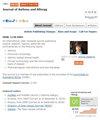本拉珠单抗治疗严重嗜酸性粒细胞性哮喘和伴有鼻息肉的慢性鼻窦炎:真实世界、多国 RANS 观察研究
IF 3.7
3区 医学
Q2 ALLERGY
引用次数: 0
摘要
目的:关于苯拉利珠单抗对严重嗜酸性粒细胞性哮喘(SEA)患者鼻息肉(NP)和哮喘疗效的实际证据以及合并NP的慢性鼻窦炎患者的实际证据非常有限。本研究的目的是在真实世界环境中评估苯拉利珠单抗治疗的嗜酸性粒细胞性哮喘和合并嗜酸性粒细胞性哮喘患者的哮喘预后:RANS是一项回顾性、多国观察研究(ClinicalTrials.gov:NCT05180357),采用SEA和合并NP成人患者的病历回顾。该研究测量了指数前(基线)和指数后(随访)12 个月内的 NP 总分 (NPS)、SinoNasal Outcome Test-22 (SNOT-22) 总分、年化恶化率 (AER)、6 项哮喘控制问卷 (ACQ-6) 和哮喘控制测试 (ACT) 分数。报告治疗后在 NPS 总分(≥ 降低 1 分)、SNOT-22 总分(≥ 降低 8.9 分)、ACQ-6(≥ 降低 0.5 分)或 ACT(≥ 提高 3 分)得分方面与基线相比有临床意义的改善:共纳入 233 名患者。基线 NPS 和 SNOT-22 总分的平均值(标准差 [SD])分别为 3.8 (2.4) 和 47.5 (22.6)。与基线相比,NPS 的平均变化(95% 置信区间 [CI])为 - 1.2(- 1.7,- 0.6),SNOT-22 的平均变化(95% 置信区间 [CI])为 - 19.8(- 23.6,- 15.9)。基线时的 AER(95% CI)为 1.2(0.96,1.41),随访时为 0.2(0.13,0.28)。基线时 ACQ-6 和 ACT 评分的平均值(标清)分别为 1.6 (1.3) 和 15.0 (5.2),随访时分别为 0.8 (1.0) 和 22.0 (3.9)。在NPS、SNOT-22总分、ACQ-6和ACT评分方面取得有临床意义改善的患者比例分别为49.1%、67.6%、56.6%和81.1%:在这项真实世界的研究中,观察到SEA和合并NP患者在开始使用苯拉利珠单抗后的12个月内NP和哮喘预后有所改善。本文章由计算机程序翻译,如有差异,请以英文原文为准。
Benralizumab in Severe Eosinophilic Asthma and Chronic Rhinosinusitis with Nasal Polyps: The Real-World, Multi-Country RANS Observational Study
Purpose: Real-world evidence of benralizumab effectiveness on nasal polyps (NP) and asthma outcomes in patients with severe eosinophilic asthma (SEA) and comorbid chronic rhinosinusitis with NP are limited. The objective of this study was to assess NP and asthma outcomes in benralizumab-treated patients with SEA and comorbid NP in a real-world setting.
Patients and Methods: RANS was a retrospective, multi-country observational study (ClinicalTrials.gov: NCT05180357) using medical chart reviews of adults with SEA and comorbid NP. Total NP Score (NPS), SinoNasal Outcome Test-22 (SNOT-22) total score, annualized exacerbation rate (AER), and 6-item Asthma Control Questionnaire (ACQ-6) and Asthma Control Test (ACT) scores during the 12 months pre-index (baseline) and post-index (follow-up) were measured. Clinically meaningful improvement from baseline following treatment, in terms of total NPS (≥ 1-point reduction), SNOT-22 total (≥ 8.9-point reduction), ACQ-6 (≥ 0.5-point reduction) or ACT (≥ 3-point increase) scores, were reported.
Results: A total of 233 patients were included. Baseline mean (standard deviation [SD]) NPS and SNOT-22 total scores were 3.8 (2.4) and 47.5 (22.6), respectively. The mean change (95% confidence interval [CI]) from baseline was – 1.2 (– 1.7, – 0.6) for NPS, and – 19.8 (– 23.6, – 15.9) for SNOT-22. The AER (95% CI) was 1.2 (0.96, 1.41) at baseline and 0.2 (0.13, 0.28) at follow-up. Mean (SD) ACQ-6 and ACT scores were 1.6 (1.3) and 15.0 (5.2) at baseline and 0.8 (1.0) and 22.0 (3.9) at follow-up, respectively. The proportion of patients who achieved clinically meaningful improvements in NPS, SNOT-22 total, ACQ-6, and ACT scores was 49.1%, 67.6%, 56.6%, and 81.1%, respectively.
Conclusion: In this real-world study, improvements in NP and asthma outcomes in patients with SEA and comorbid NP were observed during the 12 months following benralizumab initiation.
Keywords: exacerbations, comorbidity, biologics, patient-reported outcomes, SinoNasal Outcome Test-22, Nasal Polyps Score
Patients and Methods: RANS was a retrospective, multi-country observational study (ClinicalTrials.gov: NCT05180357) using medical chart reviews of adults with SEA and comorbid NP. Total NP Score (NPS), SinoNasal Outcome Test-22 (SNOT-22) total score, annualized exacerbation rate (AER), and 6-item Asthma Control Questionnaire (ACQ-6) and Asthma Control Test (ACT) scores during the 12 months pre-index (baseline) and post-index (follow-up) were measured. Clinically meaningful improvement from baseline following treatment, in terms of total NPS (≥ 1-point reduction), SNOT-22 total (≥ 8.9-point reduction), ACQ-6 (≥ 0.5-point reduction) or ACT (≥ 3-point increase) scores, were reported.
Results: A total of 233 patients were included. Baseline mean (standard deviation [SD]) NPS and SNOT-22 total scores were 3.8 (2.4) and 47.5 (22.6), respectively. The mean change (95% confidence interval [CI]) from baseline was – 1.2 (– 1.7, – 0.6) for NPS, and – 19.8 (– 23.6, – 15.9) for SNOT-22. The AER (95% CI) was 1.2 (0.96, 1.41) at baseline and 0.2 (0.13, 0.28) at follow-up. Mean (SD) ACQ-6 and ACT scores were 1.6 (1.3) and 15.0 (5.2) at baseline and 0.8 (1.0) and 22.0 (3.9) at follow-up, respectively. The proportion of patients who achieved clinically meaningful improvements in NPS, SNOT-22 total, ACQ-6, and ACT scores was 49.1%, 67.6%, 56.6%, and 81.1%, respectively.
Conclusion: In this real-world study, improvements in NP and asthma outcomes in patients with SEA and comorbid NP were observed during the 12 months following benralizumab initiation.
Keywords: exacerbations, comorbidity, biologics, patient-reported outcomes, SinoNasal Outcome Test-22, Nasal Polyps Score
求助全文
通过发布文献求助,成功后即可免费获取论文全文。
去求助
来源期刊

Journal of Asthma and Allergy
Medicine-Immunology and Allergy
CiteScore
5.30
自引率
6.20%
发文量
185
审稿时长
16 weeks
期刊介绍:
An international, peer-reviewed journal publishing original research, reports, editorials and commentaries on the following topics: Asthma; Pulmonary physiology; Asthma related clinical health; Clinical immunology and the immunological basis of disease; Pharmacological interventions and new therapies.
Although the main focus of the journal will be to publish research and clinical results in humans, preclinical, animal and in vitro studies will be published where they shed light on disease processes and potential new therapies.
 求助内容:
求助内容: 应助结果提醒方式:
应助结果提醒方式:


